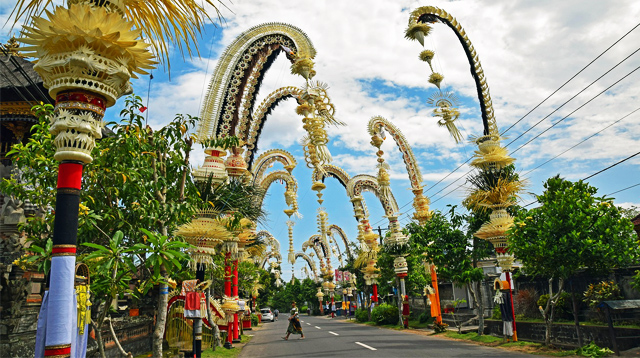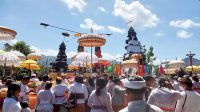DUBBED as the Island of the Gods, Bali is renowned for its vibrant culture, stunning landscapes, and unique traditions. Among these, the penjor stands tall, not just as a decorative element and symbol of deeply rooted beliefs and festive joy but also a means of ritual paraphernalia.
Picture a graceful bamboo pole, soaring meters high, adorned with intricate offerings, vibrant decorations, and woven coconut leaves. This is the essence of a penjor, meticulously crafted and erected by Balinese families during various celebrations, primarily Galungan and Kuningan.
On the celebration of Galungan and Kuningan, penjors are installed in front of entrance gates of each house compound while on temple festivals, they are installed at the entrance gates on the left and right side.
More than just decoration
Symbol of Mount Agung: The height of the penjor represents the majestic Mount Agung, believed to be the abode of the gods and a source of protection and prosperity.
Offering to the Divine: The woven coconut leaves at the top, resembling a betel nut offering, express gratitude to Ida Sang Hyang Widhi, the Supreme God. Next to the penjor stands a shrine to put offerings in relation to the ritual observed.
Celebrating Creation: The use of bamboo, associated with the god Brahma, signifies the ongoing cycle of creation and renewal.
Expression of Community Spirit: The collective effort put into crafting and displaying penjors strengthens the social bond within communities.
Aesthetics and artistry: Penjor making is an art form itself. From the meticulous selection of bamboo to the intricate weaving of palm leaves, each detail reflects the artistic talent and cultural pride of the Balinese people. Traditional ornaments, colorful fabrics, and fresh flowers further enhance the visual appeal, showcasing the island’s rich artistic heritage.
Beyond aesthetics, a glimpse into the Balinese soul:
- Gratitude and respect: The penjor embodies the Balinese people’s deep-rooted values of gratitude for blessings and respect for their ancestors and deities.
- Harmony with nature: The use of natural materials like bamboo and coconut leaves reflects the importance of maintaining a harmonious relationship with the natural world.
- Joy and celebration: During festivals, the vibrant penjors transform the streets into a festive spectacle, symbolizing joy, community spirit, and the beauty of shared traditions.
Experiencing the magic of penjor
Visiting Bali during Galungan or Kuningan offers a unique opportunity to witness the grandeur of the penjor firsthand. Stroll through the decorated streets, admire the artistry, and immerse yourself in the festive atmosphere. Remember, the penjor is more than just a sight; it’s a window into the heart and soul of Balinese culture.
So, the next time you see a penjor, don’t just admire its beauty, but take a moment to appreciate the deeper meanings and cultural significance it holds. It’s a reminder that even the simplest elements can be imbued with profound symbolism and artistic expression, offering a glimpse into the unique ways humans celebrate and connect with their world.
Attractively, cars and motorcycles belonging to the Hindus in Bali are also given offering on the celebration marked with festooned sampian on the front side. When passing the roads, you may encounter they are festooned with this.










